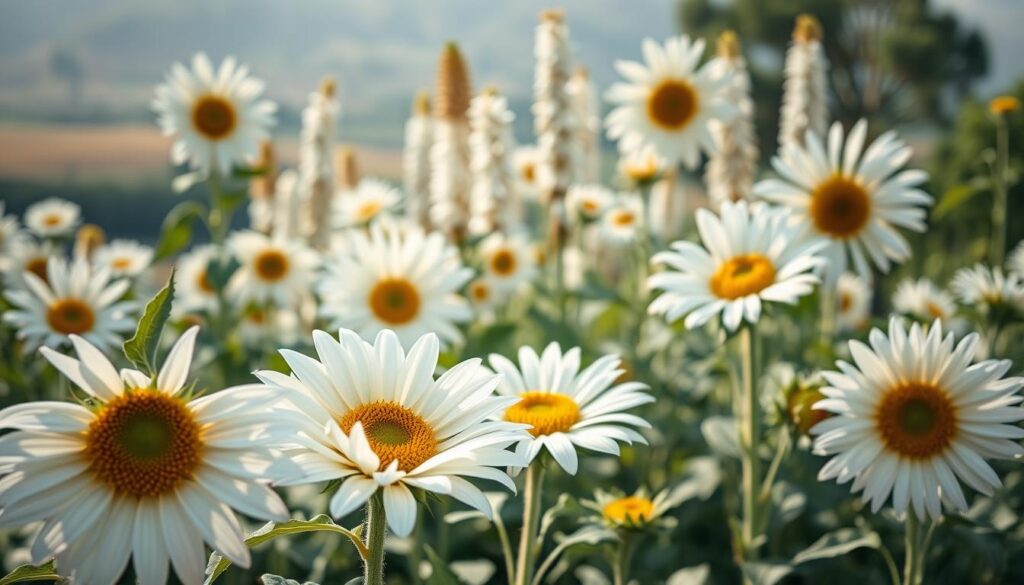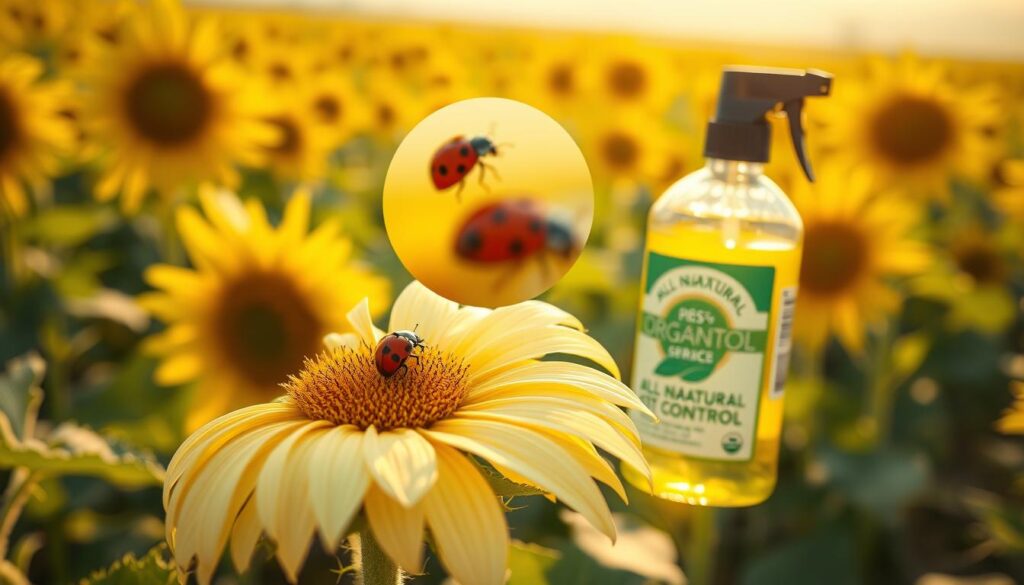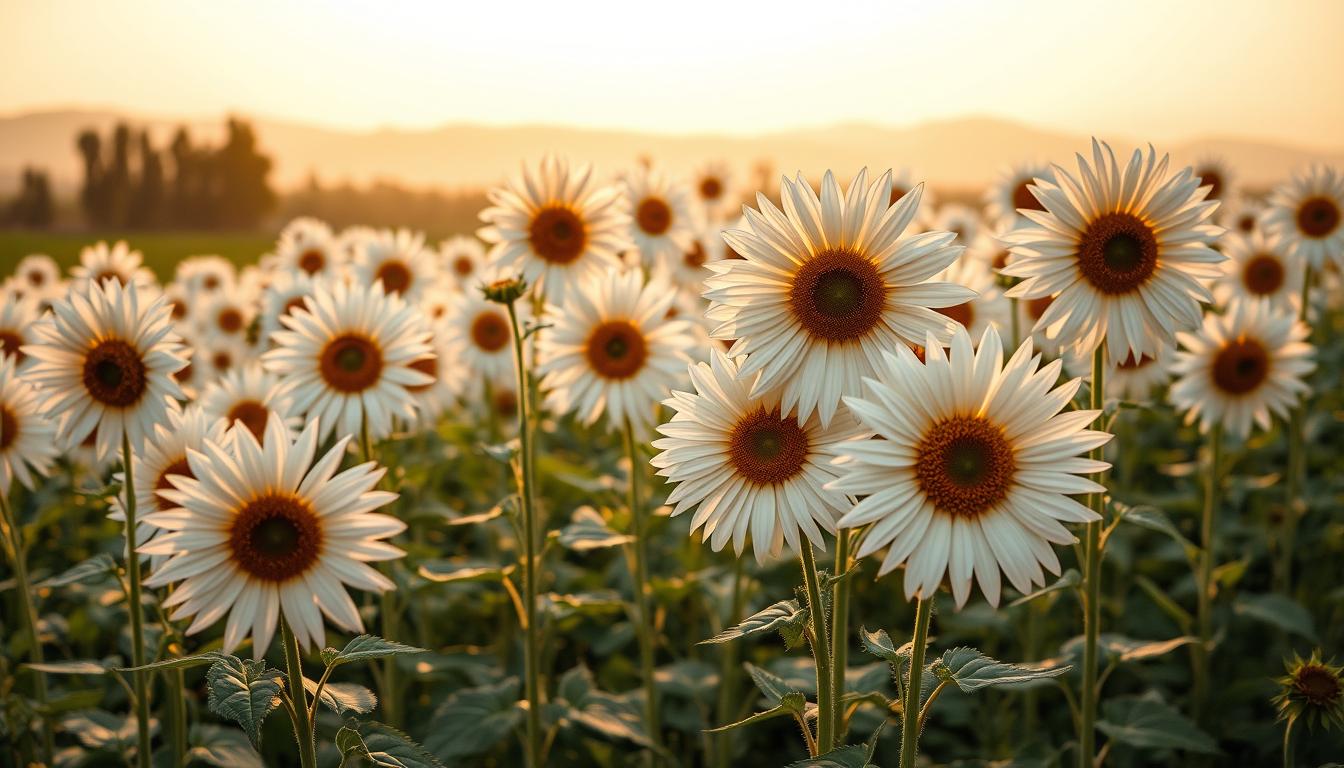Imagine walking through a garden filled with white sunflowers. Their pale petals create a peaceful scene, turning your outdoor space into a magical place.
White sunflowers are more than just flowers. They bring natural beauty to your garden. They can make your backyard look amazing and add elegance to any floral arrangement.
Table of Contents
Introduction to White Sunflowers
White sunflowers add a unique charm to summer gardens. They are different from the usual yellow ones and bring elegance to your garden. With over 150 species in the Helianthus genus, there’s a wide variety to choose from.
Sunflowers can grow from 2 to 10 feet tall, depending on the type. They are easy to grow, making them perfect for all gardeners. They are especially great for those who love gardening in the summer.
History and Origins of White Varieties
White sunflowers were created through careful breeding. They offer a fresh look in gardens, different from the usual yellow ones. This makes them a unique choice for gardeners.
- Native to North America
- Developed through selective breeding
- Represent genetic diversity within the Helianthus genus
Popular White Sunflower Cultivars
Some of the most loved white sunflower varieties are:
- Italian White – Known for delicate, creamy petals
- Coconut Ice – Features soft, pure white blooms
- Snow White – Delivers pristine, bright white flowers
Understanding Their Unique Appeal
White sunflowers offer a sophisticated choice for gardeners. They look great in flower arrangements and add a unique look to gardens. They grow fast, blooming in 50 to 80 days, making them perfect for all gardeners.
White sunflowers: Nature’s elegant canvas in your garden
Growing Requirements and Care Tips
White sunflowers are amazing plants that need special care to grow well. Knowing how to care for them will help you get great photos and healthy flowers.
Soil Preparation and pH Levels
To grow white sunflowers, start with the right soil. They prefer well-draining, nutrient-rich soil. The soil’s pH should be between 6.0 and 7.5. Test your soil first and add organic compost to make it perfect for growing.
- Optimal soil pH: 6.0 – 7.5
- Add organic compost before planting
- Ensure good drainage
Watering Schedule
Watering white sunflowers regularly is key. They require approximately 1 inch of water per week. During hot weather, they need more water. Potted sunflowers need even more water to avoid drying out.
| Growth Stage | Watering Frequency |
|---|---|
| Seedling | Keep soil consistently moist |
| Mature Plant | 1 inch of water per week |
| Hot Weather | Increase watering frequency |
Light and Temperature Needs
White sunflowers love the sun and need 6-8 hours of direct sunlight. They grow best in temperatures around 70 degrees Fahrenheit. Plant them when the soil is at least 50 degrees Fahrenheit.
“Sunflowers are nature’s solar panels, turning their faces to capture maximum sunlight throughout the day.” – Gardening Expert
By following these care tips, you’ll make a perfect spot for white sunflowers to grow. This will help you get amazing photos and healthy flowers.
Planting Guide for Success
Adding white sunflowers to your garden brings a touch of nature’s beauty. These seasonal flowers need careful planning and precise techniques for a stunning display. Knowing the right planting approach will help you create a breathtaking landscape that captures the essence of summer.
Timing is key when planting your white sunflowers. Wait until overnight frost risks have completely disappeared. Plant your sunflower seeds 1 to 1½ inches deep in well-prepared soil. The ideal spacing depends on the specific variety you’re growing.
- Plant seeds when soil temperatures reach 50-60°F
- Choose a location with full sun exposure
- Ensure soil pH ranges between 6.0 and 7.5
- Space seeds 6 inches apart in rows
Different white sunflower varieties have unique growth requirements. Dwarf varieties can be planted closer together, while taller types need more room to develop. Staggering your plantings over 5-6 weeks can help you achieve continuous blooms throughout the season.
Sunlight is crucial for your plants’ success. These seasonal flowers need 6-8 hours of direct sunlight daily. Choose a garden spot that gets plenty of sunshine and is protected from strong winds. Your white sunflowers will reward you with magnificent blooms that showcase nature’s beauty.
Most white sunflower varieties mature in 70-95 days. With consistent care, proper watering, and attention to their specific needs, you can grow a spectacular display of these elegant flowers.
Common White Sunflower Varieties
Exploring white sunflowers shows a wide range of helianthus annuus varieties. Over 70 types of white sunflowers are available. They can turn any garden into a beautiful display of pale, creamy flowers.

White sunflowers have delicate buttercream-colored petals. They add elegance to any garden. Let’s look at three unique white sunflower varieties.
Italian White Sunflower
The Italian White sunflower has a special growth habit. It grows into a beautiful, multi-stemmed plant. This adds depth and texture to gardens.
These sunflowers grow between five to six feet tall. They bring a graceful, architectural look to landscaping.
Coconut Ice Sunflower
Coconut Ice is a stunning white sunflower. It has soft, pale buttercream petals. It’s known for:
- Soft, pale buttercream coloration
- Bloom diameter of approximately 6-8 inches
- Drought-tolerant growth habits
Snow White Sunflower
Snow White is another elegant white sunflower variety. It has:
- Pale, almost translucent white petals
- Moderate height of 4-5 feet
- Resistance to various garden pests
When picking white sunflowers, think about growth habits, height, and care needs. This ensures the best growth of these beautiful helianthus annuus varieties.
| Variety | Height | Bloom Size | Special Characteristics |
|---|---|---|---|
| Italian White | 5-6 feet | 6-7 inches | Branching growth habit |
| Coconut Ice | 4-5 feet | 6-8 inches | Drought-tolerant |
| Snow White | 4-5 feet | 5-6 inches | Pest-resistant |
Benefits of Growing White Sunflowers
White sunflowers add magic to your garden and flower arrangements. They offer more than just beauty. They bring many benefits that garden lovers and flower fans will enjoy.
Here are the top reasons to grow white sunflowers in your garden:
- Attract beneficial pollinators like bees and butterflies
- Create stunning focal points in summer blooms
- Enhance garden aesthetics with elegant white petals
- Versatile for multiple floral arrangements
White sunflowers have a special effect on our minds. Their bright, pure look brings calm and peace to any outdoor area. The White Nite variety, for example, has delicate blooms that turn your garden into a serene haven.
For those who love cutting flowers, white sunflowers are a big deal. They grow from seed to bloom in 50-60 days. This makes them a quick addition to your garden. Pair them with zinnias or celosia for stunning mixed bouquets that wow everyone.
Gardeners will love that these flowers do well in temperatures between 20°C to 30°C. They need 6-8 hours of direct sunlight each day. Plus, they can grow multiple flowers on one stalk. This means you’ll have plenty for your garden and flower arrangements.
“White sunflowers are nature’s canvas, painting joy and tranquility in every garden.”
Container Growing vs. Garden Planting
Growing white sunflowers can be done in two ways: in containers or in a garden. Each method has its challenges and benefits. It can help you grow stunning cut flowers and enjoy your gardening more.
White sunflowers can grow well in many places. Your choice between containers and a garden depends on several important factors.
Pot Selection Guidelines
When picking containers for white sunflowers, keep these tips in mind:
- Choose pots with at least two feet of soil depth to accommodate tap roots
- Select containers with excellent drainage capabilities
- Opt for dwarf sunflower varieties for container gardening
- Use pots at least 12 inches in diameter for medium-sized varieties
Spacing Requirements
Proper spacing is key for healthy growth and to prevent plant competition:
| Growing Location | Spacing Recommendation | Ideal Plant Size |
|---|---|---|
| Container Gardening | 6 inches apart | Dwarf varieties (1-2 feet tall) |
| Garden Planting | 8-12 inches apart | Standard varieties (5-6 feet tall) |
Maintenance Differences
Container and garden-grown white sunflowers need different care:
- Container Plants: Need more water and monthly fertilizer
- Garden Plants: Tolerate drought better and get natural support
- Both need direct sunlight for 6-8 hours daily
- Staking might be needed in windy areas
Success with white sunflowers depends on knowing these specific growing methods. Whether you use containers or a garden, the right care will give you beautiful cut flowers to enjoy.
Companion Planting Strategies
Creating stunning sunflower fields is more than just planting white sunflowers. Companion planting is a smart way to boost your garden’s health and beauty. It turns your garden into a lively ecosystem.
When designing white sunflower gardens, consider these powerful companion planting techniques:
- Plant marigolds near white sunflowers to deter harmful nematodes and aphids
- Integrate nitrogen-fixing plants like sweet peas to enrich soil nutrition
- Use trap crops such as nasturtiums to divert pests from your precious sunflower fields
Pollinator attraction is another big plus of companion planting. Choosing the right flowers can make your garden more diverse. Plants like bee balm and echinacea attract beneficial insects, helping plants reproduce.
Your botanical photography will get a big boost from diverse plant combinations. The mix of flowers can turn simple sunflower fields into stunning scenes.
Strategic companion planting reduces chemical interventions while promoting sustainable gardening practices.
Key companion planting principles to remember:
- Select plants with complementary growth requirements
- Consider pest deterrence capabilities
- Focus on creating a balanced, diverse garden ecosystem
Experiment with different combinations to discover the most effective companion planting strategies for your unique white sunflower garden.
Pest Management and Disease Control
Keeping your seasonal flowers safe from pests and diseases is key to enjoying nature’s beauty. White sunflowers face many challenges that need careful handling and quick action.

Knowing the threats to your sunflowers helps you create a strong protection plan. Different pests and diseases can harm your plants at different times.
Common Pests Threatening Sunflowers
- Sunflower beetles can eat up to 13% of kernel size
- Cutworms can greatly reduce plant stand
- Thrips cause leaf distortion and stunting
- Grasshopper populations over eight per square yard need control
Disease Prevention Strategies
Stopping diseases in your flowers needs a few steps. Alternaria infections can cause up to 90% yield loss in subtropical areas. Important prevention steps include:
- Keep plants far apart
- Ensure good airflow
- Watch plants closely
- Choose disease-resistant varieties
Natural Treatment Methods
Natural treatments are good for the environment when dealing with pests and diseases. Using integrated pest management helps keep your garden safe without harsh chemicals.
- Use neem oil for mild infections
- Apply overhead sprinkling to wash away spores
- Implement crop rotation
- Encourage beneficial insects
By using these methods, you can manage pests and diseases well. This way, you can keep the beauty of your white sunflowers safe.
Harvesting and Storage Tips
Harvesting white sunflowers for cut flowers and seeds needs careful timing and technique. Your sunflowers are ready when the back of the flower head turns brown, usually 30 to 45 days after blooming.
For the best cut flowers, follow these essential steps:
- Harvest stems early in the morning when the flowers are at their most hydrated.
- Use sharp, clean pruning shears
- Cut at a 45-degree angle to maximize water absorption
- Remove lower leaves that would sit below the water level
When preparing sunflowers for seed harvesting, watch for these key indicators:
- Petals have fallen
- The flower head back turns dark brown
- Seeds appear plump and fully developed
Storage is key for keeping seed quality. Keep harvested seeds in an airtight container in a cool, dry location. They can stay viable for up to one year when stored right.
| Harvesting Stage | Key Characteristics | Storage Recommendation |
|---|---|---|
| Seed Maturation | Brown flower head back | Dry in cool, dark area for 4-5 days |
| Seed Cleaning | Remove debris | Air-dry thoroughly |
| Seed Storage | Fully mature seeds | Airtight container, cool location |
For floral arrangements, white sunflowers can last over a week when cut right. Protect your harvested seeds from wildlife by covering flower heads with lightweight mesh bags. This ensures a successful seed collection for future planting.
Creative Uses in Garden Design
Turn your garden into a masterpiece with white sunflowers. These plants are perfect for creative garden designs. They can make your outdoor space look amazing.
White sunflowers are great for making unique garden landscapes. Their elegant blooms can add interest and texture. They’re ideal for those who love gardening and want to make their space stand out.
- Create natural privacy screens using tall sunflower varieties
- Design captivating border gardens with layered sunflower heights
- Develop vertical garden arrangements using trellises and stakes
- Craft whimsical sunflower mazes for interactive garden experiences
Make the most of your garden by mixing white sunflowers with other plants. Dwarf varieties are great for small areas like balconies. Larger ones can mark paths and be stunning focal points.
For the best design, try these planting tips:
- Plant shorter sunflowers in front, taller ones in back
- Mix sunflower heights for depth and dimension
- Incorporate companion plants like marigolds to enhance ecosystem health
- Use branching sunflower types for prolonged blooming periods
Your garden can be a canvas where white sunflowers bring joy. They attract pollinators and create stunning summer scenes. Your garden will show off your style and creativity.
Conclusion
White sunflowers (Helianthus annuus) can change your garden into a beautiful place. They are not just pretty to look at. They also show strength, beauty, and a long history of farming.
Growing white sunflowers can be very rewarding. You can grow them in pots or big gardens. They are good at surviving without much water and attract bees and butterflies.
Enjoy growing these amazing flowers by knowing what they need. With the right care and soil, your garden will be a stunning sight. It will show off nature’s beauty and your love for it.
Begin your white sunflower adventure today. Your garden will become a place of beauty, help the environment, and connect you with nature’s wonders.
FAQ
What makes white sunflowers different from traditional yellow sunflowers?
White sunflowers offer a unique and elegant look. They add a softer, more sophisticated touch to gardens and floral arrangements. This creates stunning visual contrast and adds elegance to your summer blooms.
Are white sunflowers as easy to grow as traditional sunflowers?
Yes, white sunflowers are just as easy to grow. They require full sun, well-draining soil, and consistent watering. Most varieties of Helianthus annuus are low-maintenance and adaptable to different growing conditions.
Can white sunflowers be grown in containers?
Absolutely! Many white sunflower varieties are great for container gardening. Choose dwarf or compact varieties like Coconut Ice or Snow White for best results. Make sure to use a large pot with drainage holes and provide enough sunlight and care.
How tall do white sunflowers typically grow?
White sunflower heights vary by variety. Some dwarf varieties may reach 2-3 feet, while others can grow up to 6-8 feet tall. Italian White typically grows between 4-6 feet, making them perfect for gardens and cut flower arrangements.
Do white sunflowers attract pollinators?
Yes, white sunflowers attract beneficial pollinators like bees and butterflies. They provide nectar and pollen, supporting local ecosystems and garden biodiversity.
What are the best companion plants for white sunflowers?
White sunflowers pair well with lavender, zinnias, cosmos, and marigolds. These plants create beautiful combinations and help with pest control and soil health, enhancing your garden’s ecosystem.
How often should I water white sunflowers?
Water white sunflowers deeply but infrequently, once or twice a week depending on your climate. Ensure the soil is moist but not waterlogged. In hot summer months, you might need to water more often to prevent stress.
Can I use white sunflowers in cut flower arrangements?
White sunflowers are excellent for cut flower arrangements. They provide a clean, fresh look and can last up to a week in a vase. For the longest-lasting cut flowers, harvest them early in the morning when they’re fully open but not yet fully mature.
Are there any common pests that affect white sunflowers?
White sunflowers can be susceptible to pests like aphids, beetles, and cutworms. Regular monitoring, maintaining plant health, and using natural pest control methods like neem oil or introducing beneficial insects can help protect your plants.
When is the best time to plant white sunflowers?
The best time to plant white sunflowers is after the last frost in spring, typically between April and May. For optimal germination, soil temperatures should range between 50-60°F (10-15°C). This timing ensures your sunflowers will bloom during the peak summer months.

